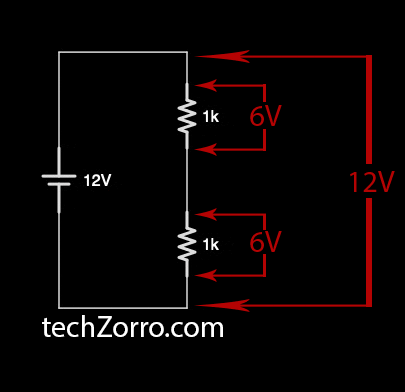This electric principle comes very handy in integrated circuits (IC). One of the most successful ICs in history, the 555, depends on them. Many microcontrollers have some kind of voltage divider inside for multiple purposes or they need them coupled onto their pins.
And that's exactly what you will learn today! But first, let's learn what is it.
Table of Contents
What is it?
It divides (or reduces) the voltage in a circuit, resulting in one or multiple voltage drops across its components, which are in most cases resistors.
Let's start my the most basic principle of electricity: Ohm's Law.
When electricity has gone from the power source to ground, it has dropped all its voltage. This means the resistor, in the image below, has the entire voltage across its pins.

Types of Dividers
Simple Voltage Divider
What happens when you put two equal resistors in series? When electricity has gone from the power source to ground passing both resistors, it has dropped all its voltage. But happens in the middle, by point A?

When you place the multimeter between point A and the negative power source, you will get half the voltage from the power source. Interesting, right?
Triple Voltage Divider and Beyond
If you add a third equal resistor, you could guess what would happen. The voltage across each resistor is divided by three. When you place the multimeter between ground and each resistor in order, you will see voltage drops equals to 3/3, 2/3 and 1/3 of the power source.

This same rule applies to more than 3 resistor in series.
Variable Voltage Divider
What if the resistors doesn't have the same values? Applying Ohm's Law, the resistor with greater resistance will take greater voltage between its pins; therefore, it will have greater voltage drop. Why does this happen? Because in order to get through a greater resistance, it requires more force.
In the following image, you can see the increased voltage drop in the 2kΩ resistor and decreased voltage drop in the 1kΩ resistor. Remember, higher resistance requires a higher force to pass through the resistance. If the first resistor would be 3kΩ, 5kΩ or 10kΩ instead of 2kΩ, the voltage drop across that resistor will keep growing.

This idea of changing resistors opens a whole new world of possiblities. As you will learn in later tutorials, this concept is the pillar for future projects that involvers sensors or transductors. Instead of one of the resistors, you could place a microphone, light sensor, heat sensor and many more.
Bridge Voltage Divider
I like this particular voltage divider because it makes you understand what “differental potential” means. That word by the way is what ‘voltage' actually means. Although it is seldom used, let's take a brief look.
When the load are balanced, then the voltage drop are equal. What happens when the switch is turned on? No current is going to flow through the switch.
However, when the load are unbalanced, then there is a different voltage drop across the resistors. When the switch is on, you will see that there is a current flowing from the higher voltage net to the lower voltage net.
Voltage Divider with Double Power Supply
What happens when you add a second power supply? If they are just in series, you could sum them and consider it a one whole power supply.
But that not the case when you add a load to it. In this example, look at the schematic and see the load resistor of 1kΩ connected by the switch.
When the switch is on, the current flows as a normal circuit would do.

But when the switch is on, the current now divides between paths. This makes the power supply act independently.

What comes next?
When you have a complex circuit and you connect and disconnect different loads, you have recalculate current and voltage drops again and again. Using the Thévenin's theorem, you don't need to recalculate everything, everything you connect a new load. This theorem is quite useful but mostly applied in electric only circuits (without semiconductors). Check it out in this blog post.
You have reached this far!
Thank you for reading the blog post. Your comments and suggestions are welcomed. At the bottom of this page, leave a message or just say hi! The whole team of techZorro will appreciate it. Don't forget to share it on social media as well.
techZorro’s Index of Content
Click on the following link to browse likewise content in the blog in techZorro. This index will help you see what you are looking for in a bird’s eye view.
techZorro's Newsletter!
If you enjoyed this blog post, please subscribe to techZorro’s newsletter so you don’t miss any future blog posts!








[…] Learn about Voltage Dividers […]